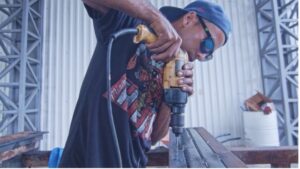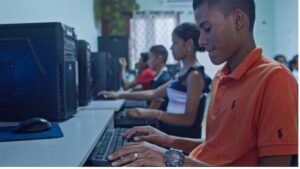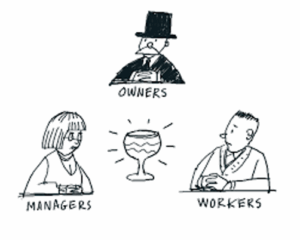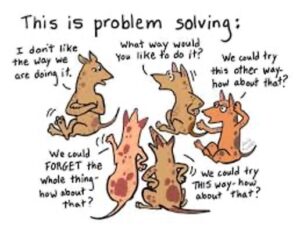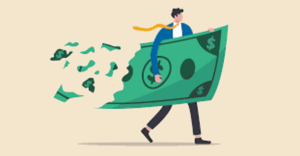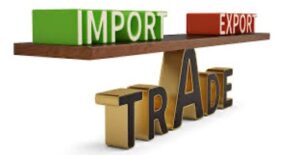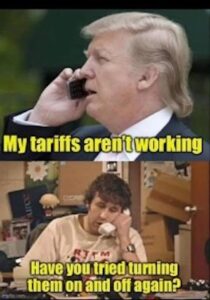The AI Revolution Is Already Here…
and It’s Changing the World Fast!

For most of my life, my interest in artificial intelligence was more curious than intense. That began to change a couple of years ago when AI-generated images and content began appearing in TV commercials, internet ads, and on social media sites. Then, about a year ago, I found out that some of the writers that worked for us were using it for research. And by the beginning of this year, it seemed like every creative person in our industry – from writers and editors to financial analysts and economists to marketers and salespeople to graphic artists and illustrators – was dabbling in it.
It was getting real, and closer to my hunting grounds, so my interest perked up. Since then, I’ve been reading and noting and filing at least a dozen stories a week. And what I’ve been seeing is an industry (actually, it’s much more than an industry, as I’ll explain) that is fast infusing itself into every nook and cranny of our economy and our daily lives.
What follows are excerpts from the first part of a White Paper I’m drafting for one of my clients – a large digital publishing company based in Japan. They themselves have been on top of this story for longer than I have. And they are already making incremental adjustments to how they are doing business, both to protect their top-ranking position in the market and to take advantage of any new opportunities for expanding their market share in the coming months and years.
They commissioned me to write this report because they sell a lot of my books on wealth building and investing over there, and they wanted me to create something they could give or sell to my readers about how to prepare for and profit from the upcoming Artificial Intelligence Revolution – which they, like I have, recognized is happening much faster than expected.
They gave me permission to publish several parts of it here, including the section where I predict what I think is going to happen in the next five years and how it is going to completely change not just our industry (information publishing) but the entire global economy.
True Story #1
If you’ve been reading this blog recently, you know that I’ve added a second story to my “cigar club” to serve as an office for me and Giovanna and an exhibition space for some of my collection of Central American modern art.
When the work was completed, I asked Gio to put me in touch with a local graphic designer to help me come up with a blueprint for a brushed aluminum sign for the exhibition space. I had a vague idea of what I wanted the sign to look like, and I wanted to work with someone local who wouldn’t charge me an arm and a leg to produce the drawing that would be used to produce it. I figured $1,500 would do it.
But Gio said, “Why not try to do it yourself with Mid-Journey.” I had no idea what she was talking about.
She showed me how to use the app in about 30 seconds. And before I even had the chance to question her about how it works, Mid-Journey had printed out its first suggestion for me.
It took less than 15 seconds. And what it gave me was exactly what I was looking for, even though I don’t think I consciously knew what I was looking for. Mid-Journey somehow figured out what I wanted and gave it to me quickly. And for free.
Question: So why would anyone ever pay a graphic designer good money for doing something they could do themself, quickly and easily, for free?
Another Quick Story
Just north of my office/ art gallery/ cigar club is an old, one-story building with several spaces that are currently occupied by a Haitian social club, a video and audio recording studio, a surf and retro-clothing shop, and one that serves as an atelier for an artist I’ve mentioned before.
It’s a nice vibe. It makes me feel like I’m part of a younger, groovier community. The occupants drop by occasionally during Happy Hour and I do business with a few of them, so it’s all good, as they say.
Last week, I was over at the recording studio checking out the soundproof room they had just built. There were about half a dozen people there – all in one way or another making a living by producing art. I asked them how their businesses were going, and they were all upbeat about the future – as they should be, given their youth, their talent, and their work ethic. (It’s not unusual for me to bump into them when I’m coming to my office in the early morning or leaving late at night.)
Since I was working on this White Paper, I asked them if they were using AI in their work.
Yes, they said, they were all using it in various ways. They all felt that the technology was rapidly developing, but didn’t feel especially threatened by it because they believe that AI can’t do the most important things that they do – the instinctive and intuitive aspects of the creative process.
But then one of them, JC, told me a story about a cousin of his that made me realize how unrealistic they were.
What JC Told Me
JC’s cousin had worked for many years as an employee of a large company that produced video TV commercials for major car makers, and had recently started his own production company to “do the same thing.”
By “doing the same thing,” I assumed he meant that his cousin would be making video ads for the kind of small companies that advertise on the internet.
No, he said. His cousin was competing with his former employer. He was actually making TV commercials that were every bit as good as those that he and a crew of other creative people did while he was working for them.
JC must have seen the look of doubt on my face, because he pulled out his phone and showed me one of them. It was a very entertaining and very polished 30-second ad for Porsche that could have been a trailer for a Mission: Impossible movie.
“That’s amazing,” I said. “The production values are fantastic,” I added (trying to sound like I knew what I was talking about). “Where did he get that done?”
“In his basement,” he said.
“What?”
Yes, he did it in his basement. An entire 30-second commercial – including script and scenery changes, all aspects of production, post-production – in his basement by himself. He had used an AI-driven video generator to create realistic scenes, AI voices for narration, and even AI actors.
“And he’s already sold it.”
“To Porsche?” I stammered.
“To Porsche,” he said.
Then he said something that sent shivers down my spine.
“He sold it for $50,000. And it only cost him $7,000 to make!”
“Really?”
“And they’ve already ordered two more!”
I am not in the TV commercial business, but like so many other things in my crazy career, I’ve been involved in it enough to know that the commercial I had just seen should have cost at least $500,000 just to make. And that the typical price a company like Porsche would pay for such a product could easily be twice that.
No wonder Porsche ordered two more!
I didn’t ask any more questions. I had been thinking about my Mid-Journey experience, and JC’s story about his cousin confirmed the hypothesis that was already forming in my mind.
If a single individual can now do the work of an entire creative team at about 2% of the cost, it means that the TV commercial industry has crossed over a threshold that will bring it into an entirely new world with brand-new supply-and-demand dynamics and into a marketplace that will soon become unrecognizable from what it had been only a year before. So how long will it take for companies in every industry to realize they could cut their TV commercial advertising budgets by 90% or more by contracting with creative people who know how to use AI?
Since then, I’ve been finding similar stories of ambitious businesspeople and entrepreneurs who are using state-of-the-art AI technology to gobble up market share and change the way business has been done.
Important: I should make this clear. This is not the future. It is the now. As you read this, AI is taking over vast swaths of high-end professions. It is not just replacing low- and middle-level repetitive jobs, it’s revolutionizing the kind of prestigious, well-paid creative work that most people assumed would be the least and last affected by it.
Faster Than Anyone Imagined
What began as an almost unnoticeable incline of development has been quietly curving upwards in the last 10 years and is now, I believe, at an inflection point where the technology will improve at lightning speed. I believe we are at the base of a hockey-stick upward rise. Like this:

The comfortable story that so many of us in creative fields have been telling ourselves – that we have until 2040 or 2050 to prepare for AI upheaval – is a delusion. And a dangerous one. Those who cling to “It won’t happen to my field” will find out the hard way that no field is safe. White-collar, blue-collar, creative, analytical – all kinds of work will be touched. And the reshuffling is going to happen at a blistering pace.
The public discourse hasn’t caught up to the velocity of the change. By the time today’s middle schoolers enter college, the economic landscape could be unrecognizable.
Here’s what I think we could be looking at:
As AI reshapes the economy, entire sectors of the workforce will be radically altered, with 80% of the creative and professional work moving away from the companies and individuals that today are dominant and over to the companies and individuals that know how to use the technology to greatly diminish timetables and costs.
Moreover, this shift won’t affect just a portion of wage earners and business owners. It will affect every dimension of human interactivity: the job market, the stock market, education, healthcare, art, entertainment, government. Nothing will be untouched. It will be as if every aspect of the way we live and work today has been flipped upside down and then completely reset.
Over the next five years – but starting as early as the end of this year – we are going to see entire industries radically shrinking or disappearing altogether, and trillions of dollars changing hands in a very short span of time.
I am envisioning an America whose population has been reorganized into three new economic communities: those that are lucky enough to be working in a handful of industries that will not be affected by the AI Revolution, a small group of people who see the future now and prepare themselves to profit from it, and an incredibly large group of people that will wake up one day in the not too distant future and realize they are up Shit’s Creek without a paddle.
A Quick History of How We Got Here
From Turing to GPT: A 70-Year Sprint
AI’s story begins in 1950 with Alan Turing’s question: “Can machines think?” That launched a journey from theory to practice.
Progress was slow for decades. Computers were weak, data was scarce, and AI went through repeated “winters.” But foundational pieces emerged: expert systems in the ’80s, neural nets in the ’90s, and early machine learning by the 2000s.
Then came the tipping point:
* Data from the internet and smartphones
* Cloud computing for scalable power
* Deep learning able to decode complex patterns
By 2012, AlexNet’s win in image recognition proved AI could move from lab to product – and quickly, it learned to read, write, and speak.
Moore’s Law Isn’t Enough Anymore
Moore’s Law once explained how tech doubled every two years. But AI is outpacing that curve. Between 2018 and 2024, model sizes jumped over 10,000x. GPT-2 had 1.5B parameters. GPT-4? Possibly over 1T.
As technology expert Bernard Marr notes, these models aren’t just larger – they’re smarter, faster, and integrated into daily life. Growth is now exponential, and so is disruption.
Three Breakthroughs Reshaping Work
1. Large Language Models (LLMs): Tools like GPT and Claude now write, code, summarize, and teach. In two years, they’ve gone from toys to business-critical systems.
2. Multimodal AI: Next-gen models process text, images, audio, and code – generating video, translating podcasts, and collapsing content boundaries into “super apps.”
3. Autonomous Agents: AutoGPT and Devin can plan, code, and execute tasks independently. Marr calls this “taskification” – AIs doing not just jobs, but job functions.
Why the Future Is Task-Based
AI is reshaping work at the task level first. Copywriting, onboarding, scheduling, and research are all being absorbed. It’s not manual labor being replaced first – it’s cognitive tasks.
As Marr warns, the winners won’t be job holders, but problem solvers – those who can wield AI, not resist it.
We’ve Crossed the Point of No Return
The genie is out of the bottle – and it’s not going back in. AI now touches every major industry and professional domain:
* It writes ad copy for global brands.
* It runs diagnostics in hospitals.
* It automates legal discovery.
* It generates investment reports.
* It powers logistics, pricing, and customer service.
And it’s only getting better.
Marr highlights a telling statistic: Over 90% of businesses expect to integrate AI into their operations in the next five years, but fewer than 30% have clear strategies for upskilling their workforce. That gap spells disaster for unprepared businesses and professionals – and a windfall for those who are ready.
Sources:
1. Krizhevsky, A., Sutskever, I., & Hinton, G. E. (2012). “ImageNet Classification with Deep Convolutional Neural Networks”
2. OpenAI model specs; see GPT-2 and GPT-4 architecture comparisons
3. Bernard Marr, The Great Skill Shift: How AI Is Transforming 70% of Jobs by 2030
4. Bernard Marr, How AI Agents Will Revolutionize Your Day-to-Day Life
5. Bernard Marr, AI Agents Are Coming For Your Job Tasks – Here’s How To Stay Ahead
6. Bernard Marr, The Great Skill Shift: How AI Is Transforming 70% of Jobs by 2030
7. Bernard Marr, 15 Mind-Blowing AI Statistics Everyone Must Know About Now
What’s About to Happen – and to Whom

I’m not a technologist.
But I’ve been right before. Not because I could write code or build hardware, but because I paid attention to what happens when new technologies start doing existing jobs better, faster, and cheaper. I saw it and warned my readers about it before the stock market crash in the late 1980s. I saw it and warned my readers about it during dot-com boom. I saw it and helped my readers save fortunes before the real estate bust. And I’m seeing it now… and the picture is getting clearer every day.
I made those calls, not because I was smarter than anyone else. I made them because there were very clear signals – signals of danger and signals of opportunity – for what was about to happen.
And yet in every case, the mainstream business and investment media were discounting the obvious. They were assuring businesspeople and investors that even if some sea change in the economy was about to happen, it would only bring more prosperity to everyone. They should stay calm and stay invested. Under no circumstances should they make any radical moves.
Well, they were wrong. Or they were lying.
History shows us they were wrong. I don’t think they were all lying, but I do think that the industries that were making fortunes in the years leading up to these seismic economic shifts understood that what was best for them to keep their millions rolling in would be to have their investors and shareholders do nothing.
And here we are again.
We’re standing on the edge of a sharp curve – one that will redefine how work gets done, who profits from it, and what happens to those left behind. AI isn’t just another wave of automation. It’s a full-scale reordering of economic reality.
Two Big Surprises
* AI will usher in a new kind of deflationary crisis.
* AI will wreak havoc on creative professions first.

One of the most underappreciated consequences of the AI Revolution will be its deflationary impact across a broad swath of industries. As machine intelligence takes over creative and skilled services, the market value of those services will collapse. This won’t happen gradually. It will happen in a sharp, fast wave.
Take television and video-based advertising. Today, it’s not unusual for a company to spend $500,000 to $1 million to produce a single high-end commercial. But as AI tools for scripting, casting, animating, directing, and editing mature, that same commercial can be produced – at nearly the same quality – for $50,000 or less.
Once that becomes the norm, the entire market will recalibrate. The $1 million production budgets will vanish. A few elite firms might still command $100,000 or $150,000, but not 10 times that. And while the total number of commercials made might stay the same – or even increase due to lower costs – most of that business will consolidate around a much smaller number of AI-augmented producers who can deliver 10 times the volume.
But this effect is not limited to media and marketing.
AI will drive a similar collapse in pricing and margins across:
* Creative services (graphic design, copywriting, content creation)
* Advisory services (business consulting, personal development, mental health coaching, and notably financial and estate planning)
* Legal and administrative services (contracts, compliance, documentation)
* Education and training (tutoring, instructional design, corporate L&D)
* Mid-layer tech roles (software maintenance, QA, system integration, DevOps)
* Healthcare diagnostics and recommendations (radiology, pathology, mental health, treatment planning)
* Real estate services (valuation, listing, marketing, closing support)
* Customer support and service centers (voice, email, and chat agents)
* Insurance and underwriting (claims processing, policy pricing, risk profiling)
* Architecture and engineering (drafting, modeling, simulations, project estimation)
These are industries that today represent vast portions of the global economy.
In the US alone:
* Advertising and marketing: $475 billion
* Professional and management consulting: $350 billion
* Financial advisory and estate planning: $140 billion
* Legal services: $400 billion
* Corporate IT and mid-tier tech: $600 billion
* Education and training: $250 billion
* Healthcare diagnostics and telehealth services: $300 billion
* Real estate services: $250 billion
* Customer service and support: $150 billion
* Insurance and financial underwriting: $450 billion
* Architecture and engineering services: $350 billion
Total: Over $3.7 trillion annually in the US economy alone. Global equivalents could easily exceed $30 trillion.
Even if demand for services holds steady or increases, prices won’t. The economics of these industries are about to be rewritten. Businesses that can adapt will thrive. But 80% to 90% of firms in these sectors will go under because they’ll be priced out. The gross activity – the economic output – may stay roughly the same. But the rewards will go to a fraction of the current participants.
This is not a traditional recession. It’s not about people spending less. It’s about the price of production collapsing because AI can do it faster, better, and cheaper. And it will cause a deflationary spiral – a radical decline in the value of human labor and the businesses built to monetize it – that will likely be the major cause behind the greatest economic disruption and wealth transfer since the Industrial Revolution.
It won’t happen in 30 or 40 years. It will begin within two years. It will be widespread within five.
A Five-Year Forecast
In the next 12 to 24 months, the AI Revolution will be in full swing, putting tens of thousands of companies and possibly hundreds of thousands of workers and professionals out of work.
And although this will happen across a broad swath of the economy and up and down the revenue and income hierarchy, it will happen soonest and hit hardest the companies and workers once thought immune: creative jobs, consulting gigs, and mid-level tech work. The full shock won’t register until it’s too late.
Before New Year’s Day of 2030, I believe we will have seen:
* The collapse of multiple white-collar job categories
* A wave of business failures in services once considered “un-automatable”
* A widening wealth gap, worse than anything we’ve seen since the Gilded Age
* A massive, coordinated government response that will come too late and aim in the wrong direction
Let’s break it down.
Who’s About to Be Displaced?

You’ve heard for years that factory jobs would go. And they did. But the great surprise of this next transition is that it’s coming for white-collar professionals – many of whom thought they were too smart, too specialized, or too human to be replaced.
1. Creative Professions
The biggest and most ironic casualties will be in so-called creative industries:
* Copywriters, screenwriters, and speechwriters
* Costume designers and set decorators
* Graphic artists and even composers
AI is already better than the average practitioner. It’s faster, it never sleeps, and it doesn’t ask for royalties. That means studios, publishers, and marketing departments will happily use it to cut costs and increase output. Some jobs will be preserved at the high end – but the middle will be hollowed out.
2. Advisory Services
AI will be devastating for anyone selling knowledge or advice:
* Business coaches and consultants
* Financial advisors and estate planners
* Mental health coaches and self-improvement gurus
* HR departments and in-house trainers
Already, AI can digest more information, generate more options, and tailor guidance more precisely than most human experts. A solopreneur with an AI assistant can do what once took a firm.
3. Mid-Level Tech Management
It sounds strange, but many people in the tech world – especially in middle management, systems architecture, or testing – are also at risk. That’s because AI is becoming the new layer of integration: It can write code, test systems, monitor uptime, and auto-correct.
If you’re not inventing the technology or controlling the infrastructure, you’re replaceable.
The Economic Fallout
If AI changes the business landscape and replaces the workers so drastically who gets rich?
The companies that control the platforms of change and the people who invest in them will certainly benefit, including many of today’s largest beneficiaries of the internet revolution (e.g., Nvidia, Microsoft, and Google). There will also be thousands of small- and middle-sized companies that, acting now to put themselves in the stream of the AI Revolution, will skyrocket to stardom in the next few years.
But there will be others – and it’s difficult to say exactly who right now – that will lose revenues and market share during this economic storm.
The question for you, my reader, is: Which side of this tectonic shift will you be on?
One More Story…

This happened yesterday afternoon, just before I finished editing that last section of the report.
A longstanding friend of mine, a man who once held a senior position in the movie and record industry, stopped by my cigar club/office to tell me that he was getting back into that business and he wanted to tell me why.
In the six or seven months since we had last spoken, he had joined with two people he used to know in the movie business to start a new company that was taking full advantage of AI.
I won’t tell you exactly what they are doing, because he told it to me in confidence. But I will say that in several ways it is similar to the stories I told you earlier about me using AI to design my sign and about JC’s cousin using AI to make TV commercials in his basement.
Basically, my friend is not only in the position of producing A-level movies at a tiny fraction of what studios are spending today, he is able to get the production time down to less than 30% of what it has always been. And he is doing it with AI technology – without a nickel coming from his pocket and with nearly zero risk for his investors.
His business plan was not based on speculation of what could happen in the future. (In my books and courses on entrepreneurship and investing, I have always discouraged investing “in the future.”) It was based on what was happening in real time in development, in production, and even in distribution.
The point I want to make with this story is that it seems clear to me that the traditional way of making and selling movies is doomed. And it will die a quick death – possibly in as little as two or three years.
My friend has a very good chance of being on the “right side” of that change. If I see him in another six to eight months, he may already be among an elite new type of moviemakers that take no risks while they gobble up and dominate the industry.
This is just another example of the way the AI Revolution is already starting to affect, positively and negatively, thousands of companies and millions of people.
As a result, we’re about to see the rise of a new wealth class: an AI Elite – entrepreneurs, investors, creators, and early adopters who moved early (as in this year) to surf the AI wave. Everyone else will be playing catch-up – including many well-paid professionals, business executives, and even business owners and entrepreneurs.
So… How Do You Surf on (Rather Than Get Smashed by) the Coming AI Wave?

I am going to answer this question in depth in the second part of the White Paper commissioned by my clients in Japan. In that part, I’m going to give company owners, entrepreneurs, professionals, creatives, and corporate executives a detailed list of the types of companies and jobs that are going to be severely damaged, if not extinguished, and the businesses and jobs that will survive and even thrive.
Sean Macintyre, my partner in several businesses and my co-author of the White Paper, will identify the financial asset classes that will no longer be viable in five years (so that readers can move away from them), the ones that belong in the “wait and see” category, and the ones that have the potential for explosive growth and astronomical ROIs.
In the meantime, I would urge anyone interested in preserving and/or building income and wealth to keep the opportunities inherent in the brave new world being created by the AI Revolution in mind.
Sources:
1. Advertising market size estimate sourced from IBISWorld and Statista, 2024 data
2. US professional services and management consulting revenue estimated from McKinsey and IBISWorld, 2024
3. Financial advisory and estate planning revenue based on data from the US Bureau of Labor Statistics and Deloitte, 2023
4. Legal services industry revenue from the American Bar Association and IBISWorld, 2024
5. Corporate IT and mid-tier tech services figure sourced from Gartner and IDC, 2024 estimates
6. US education and training sector value includes private tutoring, online education, and corporate L&D; sourced from HolonIQ and IBISWorld, 2024
7. Healthcare diagnostics and telehealth data from American Hospital Association and McKinsey Health Institute, 2024
8. Real estate services market size estimate based on National Association of Realtors and IBISWorld data, 2024
9. Customer service and support sector estimates from Zendesk, Forrester Research, and Deloitte, 2023–2024
10. Insurance and underwriting revenue estimates from S&P Global and NAIC, 2023
11. Architecture and engineering market size based on AIA (American Institute of Architects) and industry reports, 2024
12. Global equivalents projected based on World Bank global GDP and sectoral multipliers
What If I’m Wrong?
I’ve written this report rhetorically, trying to convince you that my view of how quickly and drastically AI is going to change our world is logical, even irrefutable.
Could it be that I’ve left out certain important facts that I should have known and considered? Is it possible that my enthusiasm overtook my sense and that although AI will change the world, it won’t happen as quickly and as greatly as I’m predicting?
Yes, I may be wrong. But what if I’m right?
If I’m right, that means that you, me, everyone reading this will experience the greatest economic transition since the Industrial Revolution. But unlike that revolution, this one won’t take 20 to 30 years. It will happen in five years, with your ability to prepare for it and profit from it in a shorter window – the next two years.
Why would you dismiss this as something you don’t have the time or the inclination to think about when, if it’s true, it could mean the difference between spending the next several years in the catbird seat for fantastic income and wealth-building opportunities or waking up one day to find that you have been left behind?
The Bottom Line
As I said at the beginning of this report, the age of artificial intelligence isn’t coming. It’s here.
The only variable now is readiness – whether companies and individuals can adapt fast enough to ride the wave rather than get wiped out by it. If you’re still treating AI like a novelty – or a long-term problem – you’re already behind.



